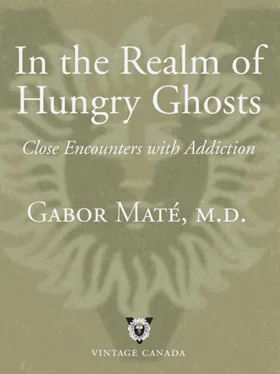ADHD and addiction have much in common, both in their characteristics and in their neurobiology. They are both disorders of self-regulation. They both involve abnormal dopamine activity—in fact, the medications used to treat ADHD are stimulants like methylphenidate (Ritalin, Concerta) or amphetamines (Dexedrine, Adderall), whose method of action is to increase dopamine activity in important brain circuits. 8The personality traits of people with ADHD and addiction are often identical: poor self-regulation, deficient impulse control, poor differentiation and a constant need to find distractions from distressing internal states. These distractions can be internal, as in tuning out, or external, as in the need to be stimulated by activities, food, other people or substances.
Thus people with ADHD are predisposed to self-medicate.
The implications are twofold. First, it is important to recognize ADHD and to treat it appropriately in childhood. As I point out in Scattered Minds, such treatment need not involve medication in every case, and in no case should medications be the only treatment. ADHD is not a disease, inherited or otherwise; it is primarily a problem of development. The key question is not how to control symptoms but how to help the child develop properly. That is the brunt of my argument in Scattered Minds, and I need not say more on it here. It is distressing to know, however, that most of the children diagnosed with ADHD are treated only with medication. Pharmacological treatment does have its place in treating both adults and children, but especially with the latter it should be used cautiously and rarely as the first-line approach. Nevertheless, the studies are clear that those children with ADHD who are not treated are at higher risk for later addictions than those who receive stimulants. 9This makes sense, of course, since on one level all substance addictions are attempts to self-medicate. According to one study, 32 per cent of adolescents who began to use methamphetamine (crystal meth) between the ages of ten and fifteen did so for the drug’s calming effect. 10Even among rats, the most hyperactive are the ones most likely to self-administer stimulants. 11
Second, when treating adults with any addiction, it is important to look for the possible coexistence of untreated ADHD. From my own personal experience and also from having worked with hundreds of ADHD adults even prior to taking on my current position in the Downtown Eastside, I know that addressing ADHD issues can be a great help to people struggling with addiction. Obversely, anyone treating adults or adolescents with ADHD must also look for addictive behaviours. It is not possible to treat ADHD successfully if we ignore addictions that may exacerbate the underlying disorder. This is so whether the person is addicted to substances or to one of several of the many behavorial addictions that our culture makes readily available and may even present in a glamorous light.
APPENDIX III
The Prevention of Addiction
A word about prevention, which is often teamed with harm reduction, treatment and law enforcement as one of the four pillars of social policy toward addiction. In practice, only the fourth—and least helpful—of these so-called four pillars receives unquestioned and generous financial support from governments.
The prevention of substance abuse needs to begin in the crib, and even before then, in the social recognition that nothing is more important for the future of our culture than the way children develop. There has to be much more support for pregnant women. Early prenatal visits should be an opportunity not only for blood tests, physical exams and nutritional advice, but also for a stress inventory in the woman’s life. All possible resources should be mobilized to help her experience a pregnancy that is emotionally, physically and economically as stress-free as possible. Employers and governments need to appreciate the crucial importance of these gestational months to the infant’s developmental well-being and, even more so, the crucial importance of the first months following birth and the first years. From any point of view—psychological, cultural or economic—that is the most cost effective approach. Children who are emotionally well nurtured and brought up in stable communities do not need to become addicts.
In my family practice days I often found myself in the ludicrous position of having to write letters explaining why it would be preferable, say, for a woman to stay at home a few months longer after the birth of her infant so that she can continue to breast feed. Our society has become so detached from this natural physiological and emotional parenting activity that it has to be justified on medical grounds. Rather than pressuring new parents—mothers or fathers—to return to work quickly, we should not spare resources to help them remain with their children for as long as possible, if that is their preference, during the crucial early developmental period. The financial savings to society would be enormous, not to mention the human benefits. If, on the other hand, early daycare is either unavoidable or happens to be the preferred option, we need to ensure that these facilities have the trained staff and the resources to provide not just physical care, but also emotional nourishment. That ought to be the case not only in daycare but throughout the child’s education.
In the case of at-risk families, the benefits of early intervention in the form of supportive home nursing visits have been well established. Such programs need to be far more broadly available, given the many troubled families in our society.
When it comes to drug education, most governments appear to view prevention largely as a matter of informing people, especially young people, that drugs are bad for them. A worthy objective, certainly, but like all behavioural programs, this form of prevention is highly unlikely to make a significant impact. The reason is that the children who are at greatest risk are the least open to hearing the message, and even if they do hear it, they are the least capable of conforming to it. Intellectual knowledge, while important, is a poor competitor for deep-seated emotional and psychological drives. If this is true for many adults, it’s even more so for children.
Children who have been abused by adults or are for any other reason alienated from adults, do not look to grownups for advice, modelling or information. And yet, as we have seen, these are the children most prone to substance use. We have witnessed the same problem with attempts to prevent or eliminate bullying: the dynamics of bullying or victimhood are rooted deep in a wounded child’s psyche. This is why moral preaching and the plethora of antibullying programs have little or no impact on the growing bullying tendencies among youth. Programs aimed at changing or preventing behaviours always fail if they do not address the psychological dynamics that drive the behaviours in question.
If schools and other childrearing institutions are to engage in drug education with a view to prevention, they need first to create an emotionally supportive relationship between teachers and students in which the latter feel understood, accepted and respected. Only in such an atmosphere can the necessary information be transmitted effectively and only in such an atmosphere will young people develop enough trust to turn to adults with their problems and concerns.
All adults concerned with the care of young people need to remember that only healthy, nurturing relationships with adults will prevent kids from becoming lost in the peer world—a loss of orientation that leads rapidly to drug use. *41
APPENDIX IV
The Twelve Steps
Читать дальше












